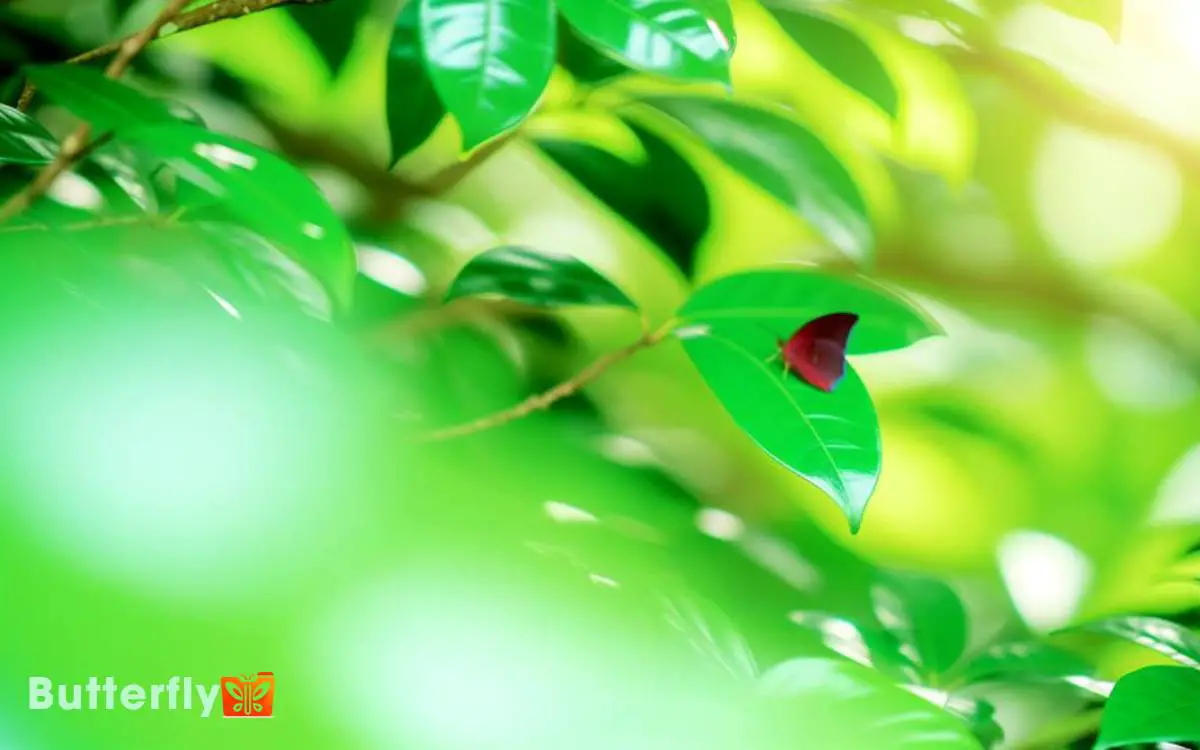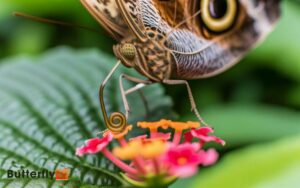Can You Eat a Butterfly? Myths and Facts Revealed!
You can eat a butterfly, but it’s important to weigh the nutritional benefits against potential health risks. Butterflies are rich in proteins, unsaturated fats, and essential micronutrients like iron and zinc.
However, they can contain toxins such as cyanogenic glycosides and environmental contaminants. Their chitinous exoskeleton may also be difficult to digest. Historically, many cultures consumed butterflies for their nutritional value.
Before eating, make sure butterflies are from pesticide-free sources and properly prepare them by removing wings and blanching the bodies.
Understanding the balance between benefits and risks is essential for those considering this unconventional food source.

Key Takeaways
Nutritional Value of Butterflies
Butterflies, like other insects, contain proteins, fats, and micronutrients that can contribute to a balanced diet. In particular, their protein content can support muscle repair and growth.
The fats found in butterflies are often unsaturated, which are beneficial for cardiovascular health. Additionally, these insects are rich in essential micronutrients such as iron, zinc, and B-vitamins, all of which play crucial roles in metabolic processes.
Consuming butterflies could provide you with a nutrient-dense food source, especially in regions where other protein sources are scarce.
While the idea may seem unusual, the nutritional profile of butterflies is comparable to other edible insects, making them a viable option for supplementing your diet with necessary nutrients.
Historical Consumption of Butterflies
Throughout history, various cultures have incorporated butterflies into their diets, utilizing them as a readily available and nutrient-rich food source. Ancient tribes in Africa and South America would collect butterfly larvae, known as caterpillars, for their high protein content.
In some regions of Mexico, indigenous groups consumed butterflies during certain seasonal migrations, capitalizing on their abundance. The practice wasn’t limited to larvae; adult butterflies were also eaten, often roasted to enhance flavor and texture.
These practices highlight the significance of early human diets, where insects, including butterflies, played a vital nutritional role.
By understanding these historical consumption patterns, you gain insight into the diverse dietary adaptations humans have developed to survive and thrive in various environments.
Cultural Perspectives on Eating Insects
Examining the cultural perspectives on eating insects reveals that many societies today still embrace entomophagy, viewing it as a sustainable and nutritious practice.
In countries like Thailand and Mexico, insects such as crickets and grasshoppers are integral to local cuisine. These cultures recognize the high protein content and low environmental impact of insect consumption.
In contrast, Western societies often exhibit a reluctance to adopt entomophagy due to ingrained food preferences and misconceptions. However, recent shifts toward sustainability have spurred interest in alternative protein sources, including insects.
Understanding these cultural differences highlights the need for educational initiatives to overcome biases and promote the benefits of entomophagy.
You can appreciate how cultural context shapes dietary practices and perceptions of entomophagy.
Health Benefits and Risks
You may be curious about the nutritional content of butterflies, which can include proteins, fats, and essential micronutrients.
However, potential toxicity is a significant concern, as some butterfly species contain harmful substances like cyanogenic glycosides.
Evaluating both the health benefits and risks is vital before considering butterflies as a food source.
Nutritional Content Overview
Though butterflies aren’t commonly consumed, understanding their nutritional content reveals both potential health benefits and risks.
Butterflies contain proteins and essential amino acids, contributing to muscle repair and growth. Their fat content, mainly in the form of healthy unsaturated fats, can support cardiovascular health.
Additionally, they provide micronutrients such as vitamins B and E, which play roles in energy metabolism and antioxidant protection, respectively.
However, it’s important to take into account the risks. Butterflies can accumulate environmental toxins, and their exoskeletons contain chitin, a polysaccharide that can be hard to digest.
While some cultures may safely include them in diets, you should be cautious and aware of both the nutritional benefits and the potential digestive challenges associated with butterfly consumption.
Potential Toxicity Concerns
When considering the consumption of butterflies, it’s important to be aware of the potential toxicity concerns due to their ability to accumulate environmental toxins and pesticides.
Butterflies often inhabit areas where chemical insecticides are used, which can result in bioaccumulation of harmful substances.
Additionally, many species contain natural toxins like cardenolides and alkaloids, which they derive from host plants. These compounds can be harmful or even fatal if ingested in significant quantities.
Also, some butterfly species may harbor pathogens or parasites that pose health risks to humans. It’s vital to understand these risks and seek guidance from experts in entomophagy or toxicology before consuming butterflies. Always prioritize safety and informed decision-making.
Ethical Considerations
When considering the ethics of eating butterflies, you should evaluate the insect rights debate, which questions the moral implications of consuming sentient beings.
Additionally, assess the environmental impact concerns, as butterfly populations play vital roles in ecosystems.
Insect Rights Debate
Considering the ethical implications of consuming butterflies, the debate often centers on whether insects should be granted rights similar to higher animals.
You might wonder if insects, including butterflies, possess the capacity for suffering or consciousness.
Scientific research on insect sentience is still developing, but some argue that, like mammals and birds, insects can experience discomfort. This raises questions about their moral standing and our obligations.
| Aspect | Consideration |
|---|---|
| Sentience | Can insects feel pain? |
| Ecological Role | Importance in ecosystems |
| Ethical Status | Should they have rights? |
| Consumption | Is it morally permissible? |
Understanding these aspects helps you navigate the complex ethical landscape surrounding insect rights and their potential consumption.
Environmental Impact Concerns
Evaluating the environmental impacts of consuming butterflies involves examining their critical roles in ecosystems and the potential consequences of their removal.
Butterflies serve as pollinators for various plant species, contributing to biodiversity and ecosystem stability. They also provide essential food sources for predators like birds and small mammals.
Disrupting butterfly populations can lead to cascading effects, such as reduced plant reproduction and imbalance in predator-prey dynamics.
Additionally, butterflies act as bioindicators, reflecting the health of their habitats. Consuming butterflies may inadvertently harm these ecosystems, leading to broader environmental degradation.
Hence, it’s important to take into account these ecological functions before deciding to consume butterflies, as their removal could have far-reaching negative impacts.
Cultural Sensitivity Issues
Understanding the cultural sensitivity issues surrounding the consumption of butterflies requires examining the ethical considerations and traditions of different societies.
In some cultures, butterflies hold significant symbolic or religious importance, making their consumption taboo. You must consider these cultural contexts to avoid inadvertently offending or disrespecting these traditions.
Additionally, ethical considerations include the potential exploitation of local butterfly populations, which could disrupt ecosystems and harm biodiversity.
When evaluating the consumption of butterflies, it’s important to balance cultural respect and environmental sustainability.
Always seek to understand the cultural significance and ethical implications before engaging in or promoting the practice. This approach guarantees that your actions are both informed and respectful, fostering global cultural sensitivity.
Culinary Uses of Butterflies
In certain cultures, butterflies have been incorporated into traditional dishes, leveraging their unique textures and nutrient profiles. You’ll find that butterflies are often used as garnishes or integral components in various recipes.
Their chitinous exoskeleton provides a crunchy texture, while their bodies offer protein, healthy fats, and micronutrients like vitamins and minerals.
Scientific research indicates that butterflies are a sustainable food source due to their low environmental impact compared to conventional livestock.
When considering their culinary uses, you should note that butterflies are often dried, powdered, or used whole in dishes. These insects can add both visual appeal and nutritional value to meals, making them an intriguing ingredient in the field of entomophagy (the practice of eating insects).
Is it Safe to Eat Butterflies? Exploring the Myth vs. Reality.
Many people wonder about butterflies eating habits explored. There is a myth that eating butterflies can be dangerous. In reality, most butterflies are not toxic to humans. However, it’s still not safe to eat them as they may have ingested toxic plants. It’s best to leave butterflies alone.
Potential Risks of Eating Butterflies
- Toxicity: Some butterfly species, particularly those in the family Nymphalidae, are known to be toxic. For instance, the Monarch butterfly (Danaus plexippus) ingests milkweed as a caterpillar, which contains toxic compounds called cardenolides. These toxins can remain in the adult butterfly, making it potentially harmful to consume.
- Allergies: Just like with any food, there’s a potential for allergic reactions. Insects, including butterflies, can contain proteins that some people might be allergic to.
- Parasites and Pathogens: Butterflies, like all insects, can carry parasites and pathogens. Consuming undercooked or raw butterflies increases the risk of ingesting harmful microorganisms.
How to Prepare Butterflies
Preparing butterflies for culinary use involves several meticulous steps to guarantee they’re both safe to eat and enhance the dish’s overall flavor and texture.
- First, verify the butterflies are sourced from pesticide-free environments to avoid harmful chemicals.
- Next, remove the wings, as they don’t add nutritional value and can be texturally unpleasant. Blanching the bodies in boiling water for 1-2 minutes helps eliminate pathogens.
- After blanching, you can sauté or fry the bodies to enhance their flavor, adding spices or herbs as desired. Consider pairing them with complementary ingredients like citrus or garlic to balance their natural flavors.
Proper preparation not only verifies safety but also maximizes their culinary potential.
Future of Entomophagy
The future of entomophagy hinges on technological advancements, sustainable farming practices, and increased consumer acceptance of insects as a viable food source.
You’ll find that innovations in automation and biotechnology can streamline insect farming, ensuring higher yields and consistent quality. Developing eco-friendly farming techniques, like vertical insect farms, reduces land use and minimizes environmental impact.
Cultivating consumer trust is essential; clear labeling and education on nutritional benefits can demystify insect consumption.
By incorporating insects into familiar food products, you can help normalize entomophagy. Regulatory frameworks ensuring food safety and quality will also play a key role.
Ultimately, overcoming cultural biases and highlighting insects’ sustainability and nutritional advantages will shape the future of entomophagy.
Conclusion
Consuming butterflies, like savoring a rare delicacy, offers both nutritional and cultural benefits. You’ve learned about their historical consumption, diverse culinary uses, and potential health impacts.
While there are ethical and health considerations, entomophagy presents a sustainable future food source. If you choose to explore this unique cuisine, proper preparation is key.
As with any dietary change, it’s essential to weigh the benefits and risks carefully. Embrace this practice as a responsible and informed consumer.






